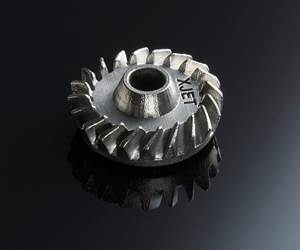Desktop Metal Expands Metal Portfolio with Chromoly Steel
Desktop Metal expands its metal portfolio with the launch of 4140 Chromoly steel for industrial applications. Studio System users will now be able to 3D print couplings, connecting rods, pump shafts, pinions, worm gears and more.
Share
Read Next
Desktop Metal has launched 4140 chromoly steel for the Studio System, an office-friendly metal 3D printing system for prototyping and low volume production. Said to be a versatile chromoly steel, 4140 is characterized by its toughness, high tensile strength, and abrasion and impact resistance, making it a key all-purpose steel for industrial applications.
“Desktop Metal is broadening its materials portfolio to include 4140 chromoly steel, enabling designers and engineers to print a broad variety of critical industrial applications, such as couplings, forks, pinions, pump shafts, sprockets, torsion bars, worm gears, connecting rods, and fasteners,” says Ric Fulop, CEO and co-founder of Desktop Metal. “Now, teams around the world will be able to leverage the Studio System to iterate quickly on 4140 prototypes and ultimately produce end-use, customer-ready parts faster and more cost-effectively.”
Early applications of 4140 parts printed with the Studio System illustrate the benefits across a variety of industries, including automotive, oil and gas, pumps and hydraulics, agriculture and defense, among others.
Automotive: Connecting Rod
A key component in combustion engines, connecting rods are used to connect a piston head to a crankshaft. During combustion, connecting rods experience significant loads and must endure high temperatures, so functional testing must be conducted using metal parts. 4140 is a key material choice for this application as it can withstand the high temperatures and mechanical stresses experienced by connecting rods. With the Studio System, users have the ability to create functional prototypes in a matter of days, and then rapidly iterate on those designs. This ensures engineers can develop efficient components and validate how they perform before committing to the manufacture of potentially millions of parts via casting or forging.
Agriculture: Mechanical Coupling
A common component in many types of machinery, mechanical couplings are used to connect two rotating parts. Where off-the-shelf parts don’t suffice, however, custom couplings must be fabricated for the specific application - a process that can be both time-consuming and expensive. The complex geometry and fine features of this particular coupling, used to attach a motor in a hopper metering system, make it a difficult and expensive part to machine. With the Studio System, the design team is able to produce a prototype of this part in a matter of days, then test its functionality in the machinery where it will be used. Printing this part allows engineers to create working models of machinery faster and with less expense. By printing in 4140, the material’s high torsional strength also enables it to stand up to the stresses couplings must withstand on a day-to-day basis.
Industry: Sheet Metal Tooling
Press brake tools are used to create bends in sheet metal with a wide range of applications - from the production of heavy-duty metal parts, to electronics enclosures. This tool in particular is used to create a custom bend angle in aluminum. The long lead times and increased costs that accompany custom tooling make it impractical for smaller or specialty jobs. Now 3D printing with the Studio System allows shops to quickly create custom tools like this one and take on specialty jobs, while still keeping cost per-part low. 4140 is an ideal material choice for the production of this press brake tool due to its toughness and resistance to impact.
4140 is the latest addition to the Studio System materials library, which also includes H13 tool steel, and 316L and 17-4 PH stainless steels. Desktop Metal plans to introduce additional core metals to its portfolio, including superalloys, carbon steels and copper.
Related Content
World’s Largest Metal 3D Printer Seen at Ingersoll Grand Opening Event
Maker of large additive and subtractive machines adds capacity in Rockford, Illinois.
Read MoreAM 101: NanoParticle Jetting (NPJ)
The proprietary process from XJet builds ceramic and metal parts using nanoparticle suspensions. Learn how NPJ works in this introductory article, part of our AM 101 series.
Read More3D Printed Cold Plate for an Electric Race Car: The Cool Parts Show #51
An unconventional lattice design and biomimicry are key to the performance of this fluid-cooled heat exchanger for a battery-powered race car.
Read More10 Important Developments in Additive Manufacturing Seen at Formnext 2022 (Includes Video)
The leading trade show dedicated to the advance of industrial 3D printing returned to the scale and energy not seen since before the pandemic. More ceramics, fewer supports structures and finding opportunities in wavelengths — these are just some of the AM advances notable at the show this year.
Read MoreRead Next
Hybrid Additive Manufacturing Machine Tools Continue to Make Gains (Includes Video)
The hybrid machine tool is an idea that continues to advance. Two important developments of recent years expand the possibilities for this platform.
Read More4 Ways the Education and Training Challenge Is Different for Additive Manufacturing
The advance of additive manufacturing means we need more professionals educated in AM technology.
Read MoreAt General Atomics, Do Unmanned Aerial Systems Reveal the Future of Aircraft Manufacturing?
The maker of the Predator and SkyGuardian remote aircraft can implement additive manufacturing more rapidly and widely than the makers of other types of planes. The role of 3D printing in current and future UAS components hints at how far AM can go to save cost and time in aircraft production and design.
Read More




















